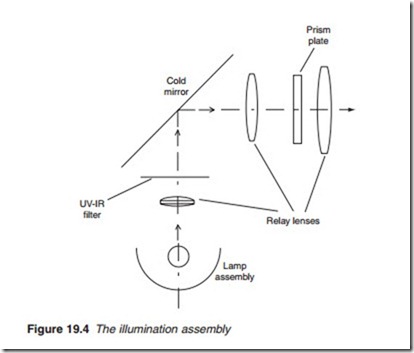DMD-based projectors
The working principles of the micro-electromechanical system (MEMS)- based DMD chip also known as DLP has been fully explained in Chapter 12.
The DMD-based projector is a reflective type in which light is reflected on and off by millions of deflecting micromirror. The deflection of the micromirrors is a result of an electrostatic force between the mirrors and address electrodes connected to a substrate of SRAM nodes. A DMD- based projector system using one chip and three chips were also explained in Chapter 13.
There are several unique advantages of DMD-based (DLP) projection systems. These include:
● Small compact size: This is especially the case with the single-chip arrangement.
● High contrast ratio: This is especially the case with the new generation of DMDs that increase the mirror tilt angle from 10 to 12º and features an absorbing coating to the substrate under the mirrors.
● High aperture ratio: As a result of the small gap between adjacent mirrors (>1 J.m) and the ability to mount the driving circuits underneath the deflecting mirrors, the aperture ratios can often exceed 90%. Visible pixel boundaries leading to the ‘screen door effect’ are therefore not a problem in DLP systems.
● Good reliability.
● Polarisation independence: With DLP systems, there is no loss associated with any polarisation of the light source.
As for the weakness of the DLP systems, they include the following:
● Manufacturing complexity and cost: The CMOS electronics in the underlying silicon substrate consists of a six-transistor SRAM circuit per pixel, and additional auxiliary addressing electronics. This drives the price of high-resolution DMD chips.
● Colour break-up or rainbow effect (single-chip only): DLP systems based on a single-panel DMD require spinning colour wheel to achieve full colour, resulting in a visible artefact known as colour break-up, or the ‘rainbow effect’ as was described in Chapter 13.
● Temporal artefacts: The binary nature of the DMD addressing process creates the sensation of temporal modulation similar to that produced by the sub-field addressing technique used in plasma panels. In fast- moving video images, the edges of moving objects can become tempo- rally unstable and appear fuzzy. Improvements in the addressing algorithms have reduced this effect, but it can still be perceived under certain viewing conditions.
● Poor colour saturation (single-chip only): In most single-panel DLP projectors, colour wheels often contain a clear (white) segment to boost brightness. Though the image appears brighter, it reduces colour saturation.
